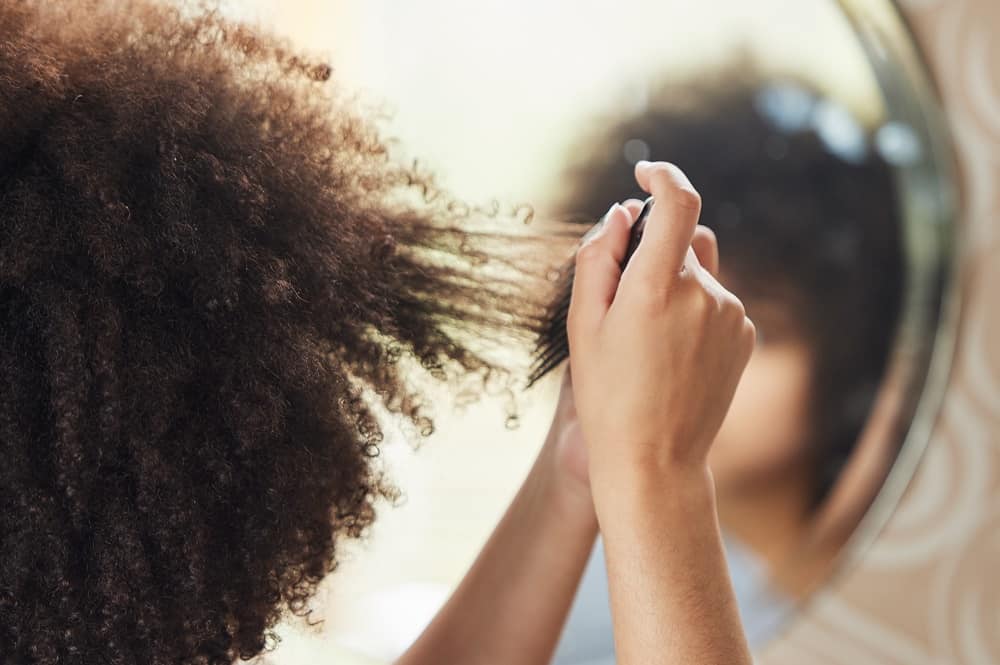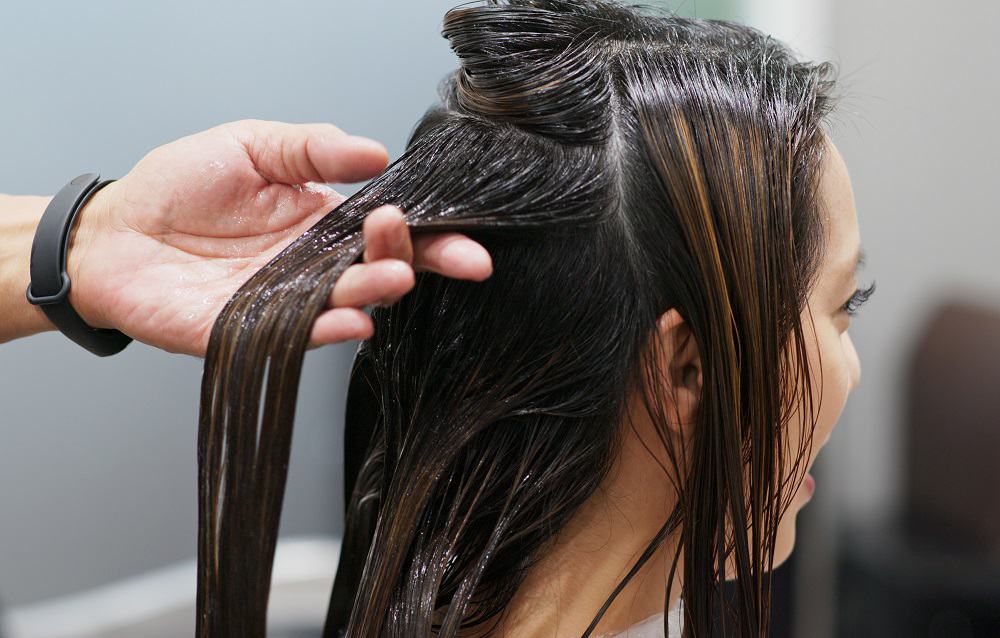Hygral fatigue causes damage to the hair as the hair cuticle becomes compromised when the hair swells. When you detangle after cleansing without pre-pooing first, you could cause a lot of damage.
2. Detangle Your Coily Hair and Keep It Stretched

The experiment at the beginning was only to help you determine which hair type you have. Once you know, there’s no need to go back to product-free hair! To detangle, section your hair first. Then add a generous amount of leave-in conditioner to the section you wish to work with.
Gently detangle with your hand first by using the praying motion to slide your hands from the roots to the tips. Then use your fingers to go between the hairs of the section to remove tangles. Once finished, wrap the section into a Bantu knot.
Bantu knots are easy to form and keep the hair in place while detangling. You can leave them in your hair until they dry to stretch your hair. Or you can go back and braid or twist the sections. Ideally, you can keep your hair stretched to some degree for the whole time before washing it again. You’ll see a lot less breakage if you twist your hair at night to keep it stretched.
3. Use Phase Styling
Try not to change your styles too much but lightly manipulate your hairstyle in phases. So if you start out in braids to stretch your hair, leave them in as an updo for as long as your hair can still look neat.
Then release the hair and wear a wavy braid-out for a few days, twisting your hair at night to keep it stretched. When the style is worn out, gather your tresses up into an updo again. Try a wash-and-go as it begins to shrink, just by spraying your hair with water and adding a curl-defining product.
2. Working with Your Hair’s Porosity

Natural 4C hair is well known for being low porosity. This means its hair cuticle has fewer holes and more densely compacted cell layers, making it hard to moisturize and hydrate. Low porosity hair is usually a genetically occurring condition, typically found in the black community worldwide.
RELATED BEST 10 ON AMAZON:
| IMAGE | TITLE | TRENDS | SEE MORE |
|---|
 | Messen Purple Detangling Brush for Natural Black Hair Detangler for Afro America Textured 3a to 4c Kinky Curly Wavy Elimin... | 23594.1 | MORE VIEW |
|---|
 | Sponsored Ad - Ombre Remy Clip in Human Hair Extensions Afro Kinky Curly 4B 4C 100% Natural Black Hair Extensions 10-22 in... | 8082.6 | MORE VIEW |
|---|
 | VTAOZI Afro Kinky Curly Hair Extensions Clip in Human Hair for Black Women 8A Brazilian 4B 4C Afro Kinky Curly Clip ins Ha... | 8775 | MORE VIEW |
|---|
 | Sponsored Ad - Loxxy Afro Kinkys Curly Hair Extensions Clip In 4B 4C Natural Hair Clip Ins Virgin Brazilian Human Hair Kin... | 5624 | MORE VIEW |
|---|
 | Sponsored Ad - Neitsi Tape In Hair Extensions Human Hair,20 Pcs Seamless Black Brown Hair Extensions Real Natural Tape In ... | 473.6 | MORE VIEW |
|---|
 | Maui Moisture Heal & Hydrate + Shea Butter Hair Mask & Leave-In Conditioner Treatment to Deeply Nourish Curls & Help Repai... | 71149.5 | MORE VIEW |
|---|
 | Tangle Teezer | The Naturally Curly Ultimate Detangling Hairbrush for 3C to 4C Hair | Reduces Frizz | Pink Mango | 205284 | MORE VIEW |
|---|
 | 2 Pack Detangling Brush for Curly Hair, ez detangler brush Hair Detangler, Afro Textured 3a to 4c Kinky Wavy for Wet/ Dry/... | 67333.2 | MORE VIEW |
|---|
 | Tangle Teezer | The Naturally Curly Ultimate Detangling Hairbrush for 3C to 4C Hair | Reduces Frizz | Pink Mango | 205284 | MORE VIEW |
|---|
 | BESTOOL Detangling Brush for Black Natural Hair, Detangler Brush for Natural Black Hair Curly Hair Afro 3/4abc Texture, Fa... | 172168 | MORE VIEW |
|---|
 | Maui Moisture Heal & Hydrate + Shea Butter Hair Mask & Leave-In Conditioner Treatment to Deeply Nourish Curls & Help Repai... | 71149.5 | MORE VIEW |
|---|
 | 2 Pack Detangling Brush for Curly Hair, ez detangler brush Hair Detangler, Afro Textured 3a to 4c Kinky Wavy for Wet/ Dry/... | 67333.2 | MORE VIEW |
|---|
 | Detangling Brush for Curly Hair Black Detangler, Afro Textured 3a to 4c Kinky Wavy for Wet/Dry/Long Thick Curly Hair (Pink) | 53433.6 | MORE VIEW |
|---|
 | Sponsored Ad - NITION Negative Ions Ceramic Hair Dryer with Diffuser Attachment,Ionic Blow Dryer Quick Drying,1875 Watt 2 ... | 47844 | MORE VIEW |
|---|
 | 3 Pack Hair Detangler Brush for Afro America/African Hair Textured 3a to 4c Kinky Wavy/Curly/Coily/Wet/Dry/Oil/Thick/Long ... | 42636 | MORE VIEW |
|---|
 | Sponsored Ad - tgin Butter Cream Daily Moisturizer For Natural Hair - Dry Hair - Curly Hair - Hair Styling Product - Curl ... | 26910 | MORE VIEW |
|---|
 | Messen Purple Detangling Brush for Natural Black Hair Detangler for Afro America Textured 3a to 4c Kinky Curly Wavy Elimin... | 23594.1 | MORE VIEW |
|---|
 | Morris African American Mannequin Head With 100% Human Hair Hairdresser Manikin Curly hair Head Training Head Cosmetology ... | 18612 | MORE VIEW |
|---|
Tips: "Amazon, Amazon Prime, the Amazon logo and Amazon Prime logo are trademarks of Amazon.com, Inc. or its affiliates". AS AN AMAZON ASSOCIATE, WE EARN AFFILIATE COMMISSIONS FROM QUALIFYING PURCHASES.






















